Standing in the Limpopo Riverbed between South Africa and Zimbabwe. © Kirstin Scholtz/ WildArk
Katherine Kuntz’s thick southern accent, bubbly personality, and striking good looks are not what you’d expect to find in the African bush. Born and bred in Houston Texas, Katherine went from living and working in the fourth largest city in the US, to dressing in Khaki, carrying a rifle and working as a backup Field Guide in South Africa in the space of a year. Katherine completed her Field Guide Training with Africa’s leading field guide training company EcoTraining, and was working as a backup guide in the Makuleke Concession when we caught up.
WildArk: What made you decide to do the one year Field Guide training course?
Katherine: I struggled to find what I wanted to pursue as a career. While working in PR, my friend offered me the chance to climb up Mount Kilimanjaro to raise funds for her non-profit in Tanzania called Neema International and I eagerly signed up! Once on the climb, the physical and mental challenges turned into self-exploration and I soon realized that nature, conservation, sustainability and the desire to do something greater than myself was where my passions truly lay.
WildArk: What are you now qualified as?
Katherine: I am a beginner vehicle-based field guide, which means I can legally take guests out on game drives, and a back-up trails guide, which means I’m the second rifle on walks in the bush with any of the Big 5 — lion, leopard, elephant, buffalo and white or black rhino. I achieved my Level 3 Tracker qualification and Wilderness First Aid Level 1 & 2. Other EcoTraining courses I passed and participated in were Basic & Advanced Birding and Navigation & Orientation.
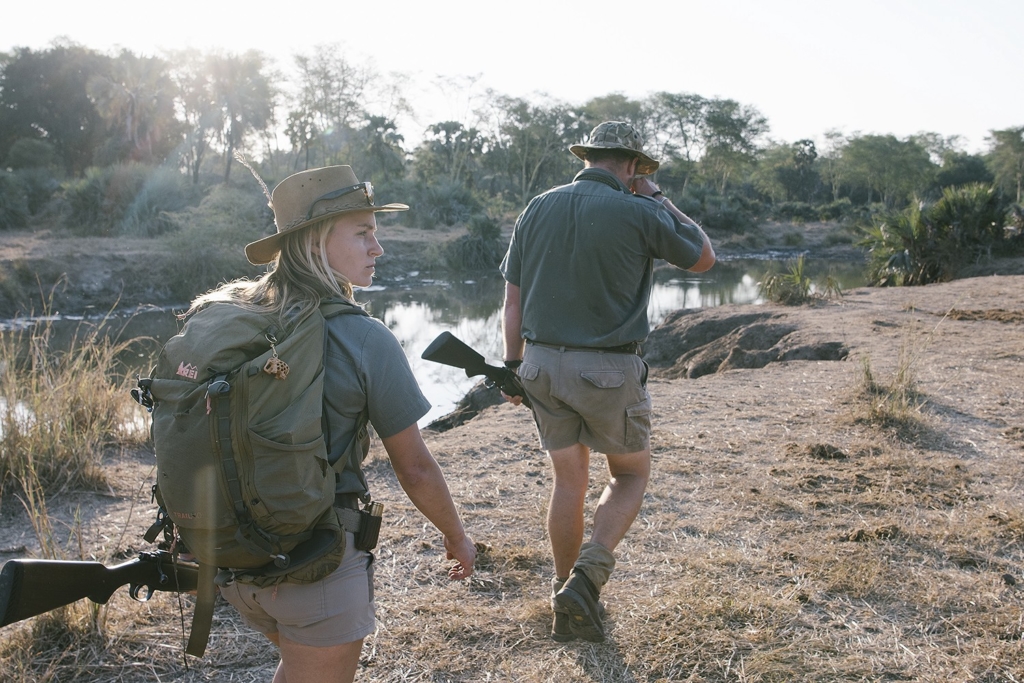
Katherine keeping her eye’s ‘peeled’ during a walk in the Makuleke Concession as a ‘Back-Up’ guide. © Kirstin Scholtz/ WildArk
WildArk: What does it mean to be a Back-Up Guide?
Katherine: Being a Back-Up with EcoTraining means you have the opportunity to gain exposure and instructor mentorship at the bush training camps in Southern Africa. Your main goals are to acquire walking hours and encounters toward your Trails Guide qualification. As a Back-Up, you are the second in command to the Lead Guide and your responsibility is to be fully focused on your “situational awareness.” Situational awareness is extremely important when you are guiding in the natural environment. This means you are using all your senses — sight, sound, taste, smell and touch — to understand what is occurring around you. As a Lead or Back-Up Trails Guide, you have to be able to multi-task and understand the signs to keep your guests safe in the unpredictable wild. By being alert and attentive always, you are able to think one step ahead and react to any incident or situation that comes your way.
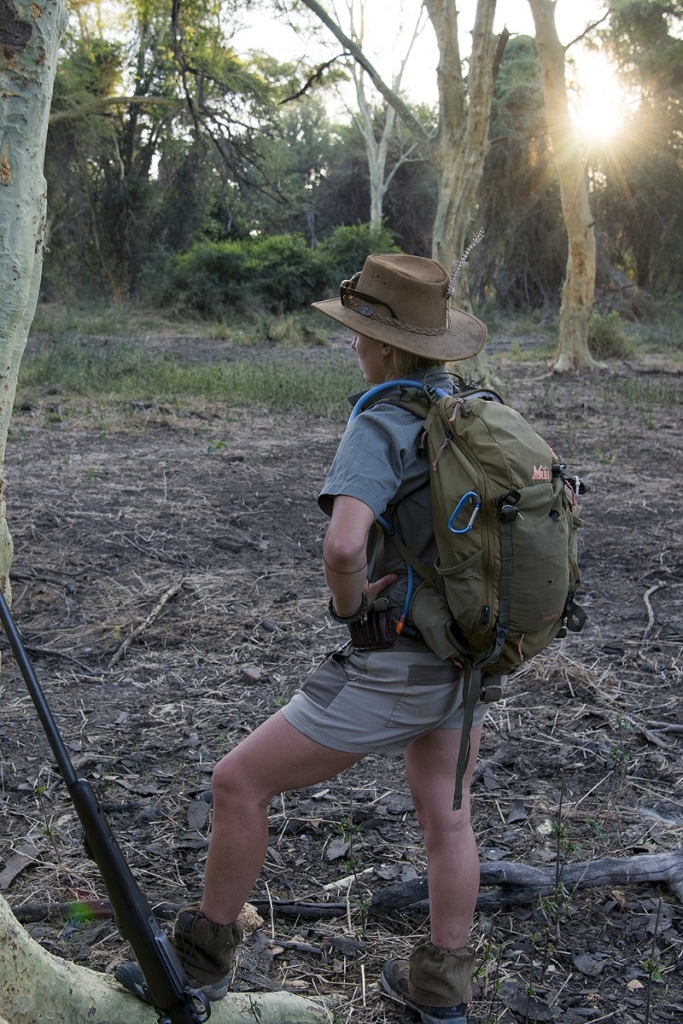
In the Fever Tree Forest in Makuleke, South Africa. © WildArk/ Kirstin Scholtz
WildArk: Can you describe your single favorite wildlife encounter over the past year?
Katherine: I was on foot during my Trails Guide Course in January of this year at the Makuleke Camp in Northern Kruger National Park. One afternoon, my training group went out with our visiting instructor and we experienced six encounters in one single walk. This included both buffalo and elephant. Although the terrain was quite thick and dense as a result of the summertime rains, we kept bumping into and seeing animals left and right. At one point, a large bull elephant, who was half-sleeping and browsing amongst the trees, walked less than 10 metres away from us. He even made a point of swinging his head in our direction almost as if to say, “Hey, I know you guys are all there! Don’t worry about me!” This was a special moment for me because it was during the beginning stages of my training, where I was exposed to the excitement that nature can offer when experiencing it on foot.
WildArk: What about your scariest moment?
Katherine: I had a very intense encounter that will be engrained in me forever. Towards the end of my year-long course at the Mashatu Camp in Botswana, my group had a very close encounter with a breeding herd of elephants during one of our morning walks. Halfway through our outing, we stopped and positioned ourselves safely on top of a rocky outcrop north of camp. One of the females though caught wind of our instructor’s scent, who at this point had moved down closer. As a result, the herd became aware, agitated and began mock charging and climbing towards us along the sandstone incline. Thankfully, we defaulted back to our training, staying quiet and still. By expressing this outward calm disposition, our instructor was then able to carefully move back up the rocks away from the irritated matriarch.
WildArk: What are your day-to-day responsibilities as a Back-Up?
Katherine: You are expected to participate in a number of tasks around camp including vehicle checks, refueling and starting the generator when needed, cleaning the camp, taking rubbish to the dump, assisting with food delivery, etc. We also sometimes have to conduct conservation management by clearing the roads and pathways from overgrown bush, creating bolsters and mitre drains to mitigate erosion and even assist with building and maintenance of camp infrastructure.
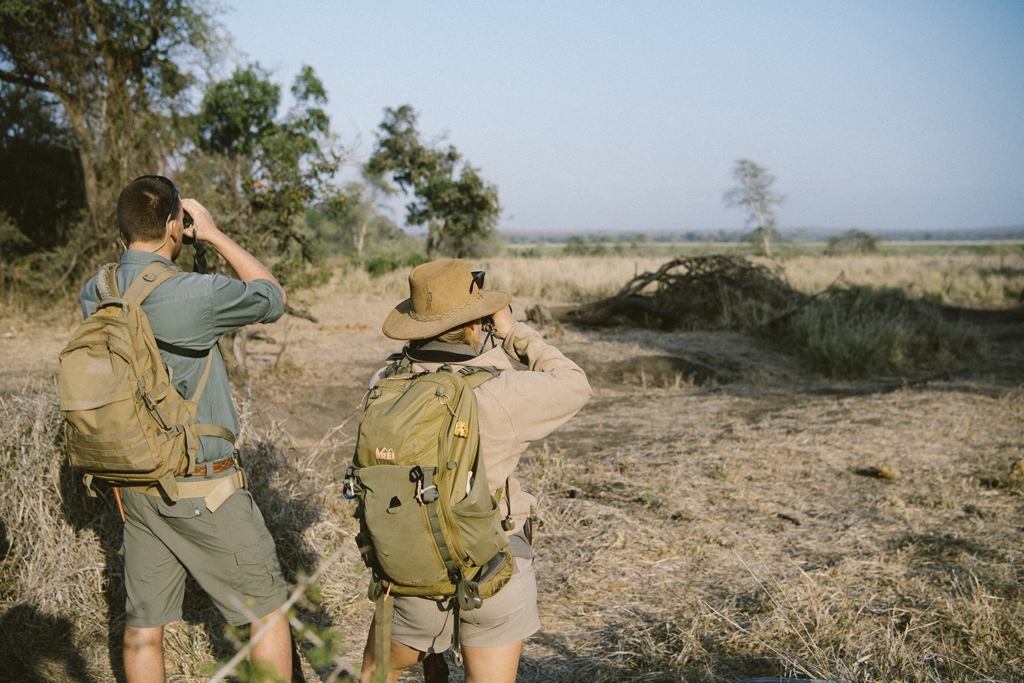
Jasper and Katherine survey through binoculars to look for any possible danger before entering on foot. © Kirstin Scholtz/ WildArk
WildArk. It seems like there are more females in this line of work than ever before. What do you think they bring to the industry?
Katherine: In guiding and ecotourism, I believe women bring a positive emotional side to the “macho” stereotype that the industry has embodied since its inception. With our innate maternal instinct, we bring a different perspective to the bush, which allows us to respond in a more sensitive manner to the ever-changing environment around us.
WildArk: You carry a rifle quite comfortably. Did this take a lot of training/getting used to?
Katherine: All Back-Ups must obtain their Advanced Rifle Handling prior to starting their trails training. This certification has several different proficiencies both theory and practical that one must pass beforehand. Once complete, you then conduct the assessment, which consists of different exercises that test distance, accuracy and real-life scenarios with dangerous game. All exercises have certain time limits as well, which affects your score. In Texas, I had previously completed some training and practice with handguns. Before the assessment specifically though, I had the opportunity to shoot with a fellow Back-Up ahead of me and also actively signed up for some additional coaching lessons.
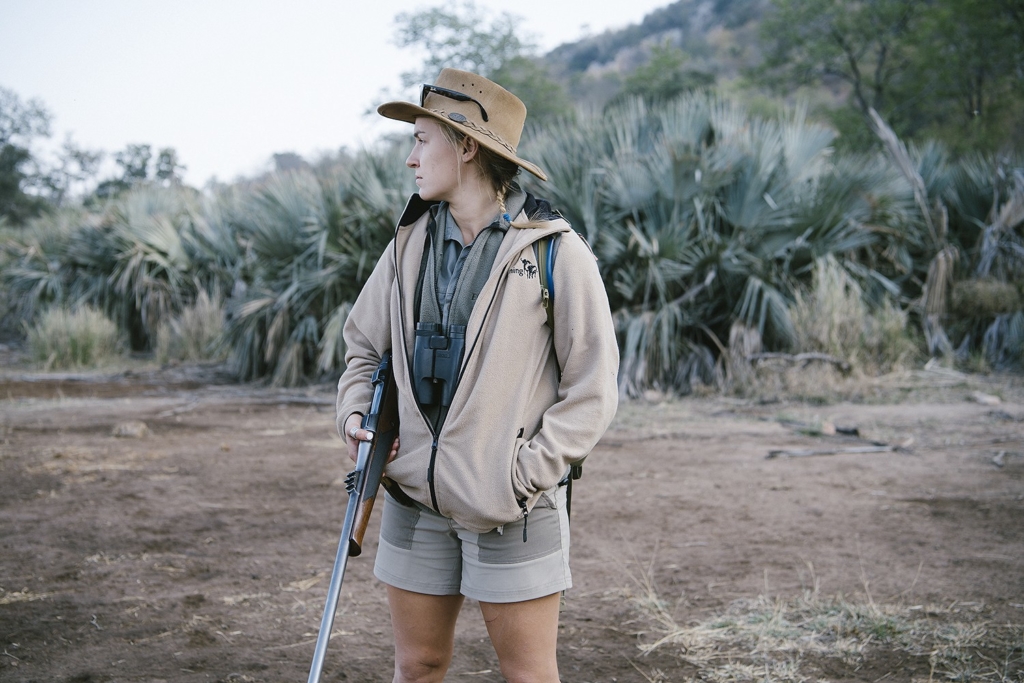
Situational awareness is key to being a good back-up guide. © Kirstin Scholtz/ WildArk
WildArk: Can you explain why guides need to carry rifles in South Africa?
Katherine: The reason for carrying a rifle is for the safety of your clients in areas that have the Big 5. Although we as trails guides take every precaution possible to keep everyone safe, situations can still occur. We are trained to use our rifles only as a last resort. As ethical trails guides, we should do everything safely possible to mediate and diffuse the situation without having to wound or kill the animal or have the animal harm you or a guest.
WildArk: What do you like most about living in the African bush. How different is it from your life in the U.S.?
Katherine: Life in the African bush is definitely different to my life in one of the largest cities in the U.S.! First off, the only traffic is the occasional herd of animals. What I do enjoy most is the simplicity overall. I enjoy carrying the bare necessities and the lack of access to proper cell signal at all times. I also love the constant peace and quiet and the ability to soak up the incredible sounds, smells and sights that the wild has to offer. By living in this type of environment, you are able to connect with others personally and spend time self-reflecting on your spirituality, values and dreams.
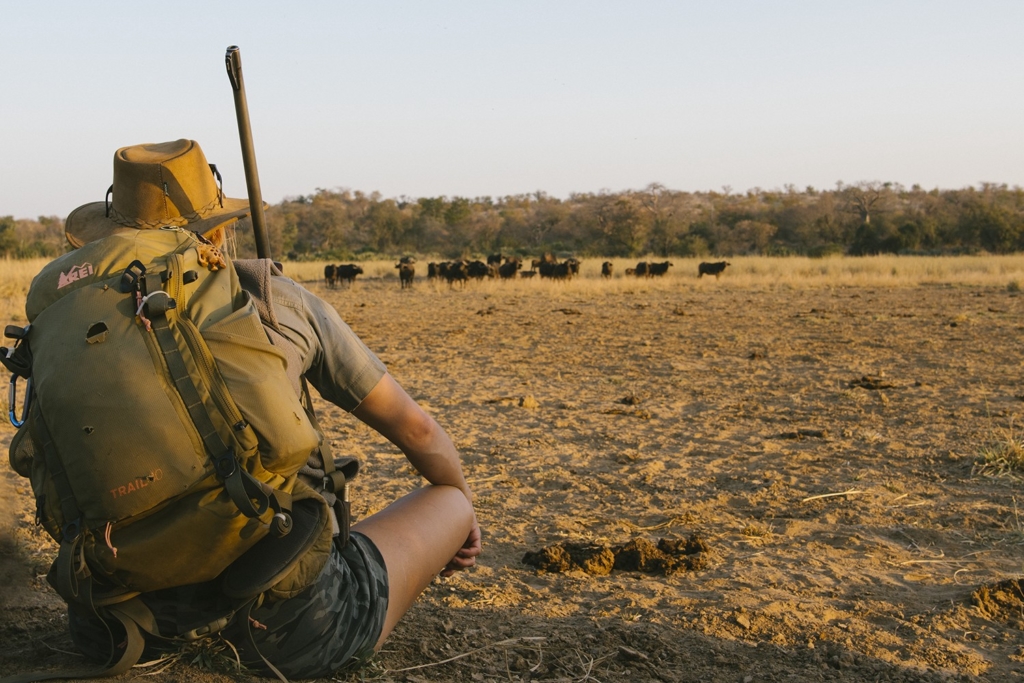
Katherine enjoying a buffalo encounter on foot in the Makuleke Concession. © Kirstin Scholtz/ WildArk
WildArk: What has been the steepest learning curve?
Katherine: Being a foreigner, I was starting from scratch with my knowledge. I arrived with very little understanding regarding the ecology, weather, species, history and cultural norms of the country. South African students have the advantage of their native foundation and roots. Many of them have even grown up in or around nature in some capacity. Although this divide can be challenging at times, I believe the best things in life require hard work and perseverance, so one must have unwavering determination to overcome these types of difficulties. As I always say, by starting from the bottom you have no other way of going but up!
WildArk: What are you most passionate about within this line of work?
Katherine: I am passionate about the incredibly bright, hard-working and inspiring individuals I get to be around each and every day in the field. And of course, I love working in an industry that brings together all my interests — animals, the environment, community and education.
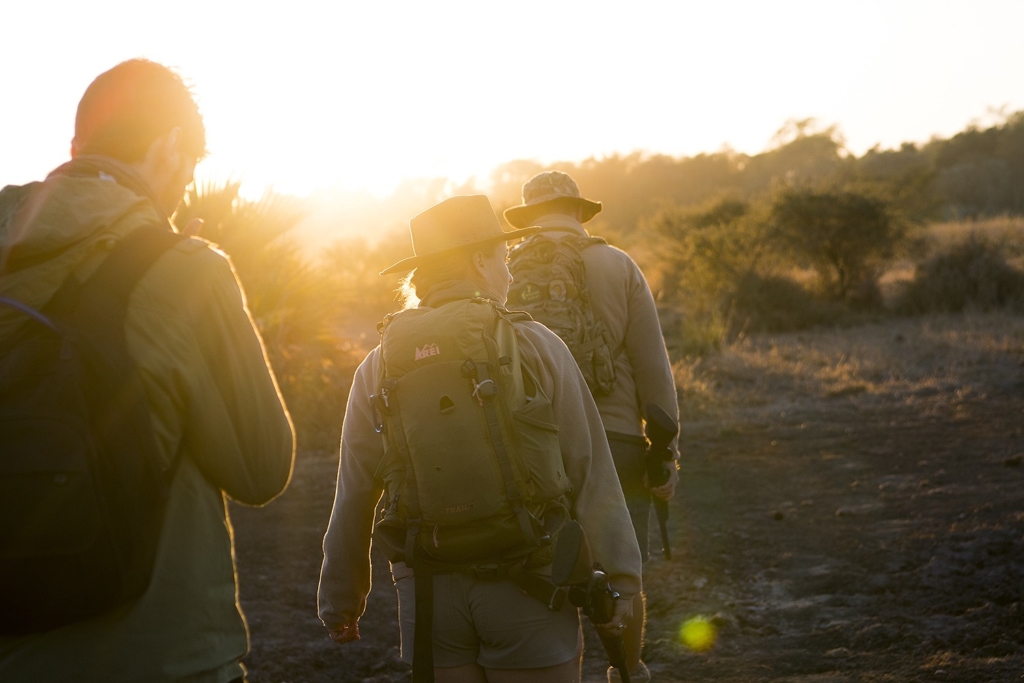
Early morning walks are some of the best. © Kirstin Scholtz/ WildArk
WildArk: Why should people do this course?
Katherine: I am a huge proponent of people not only joining EcoTraining, but exploring other wilderness areas globally for several reasons. By participating on a course in southern Africa specifically, you will be exposed to an exotic environment with amazing flora, fauna and wildlife. You will also have the opportunity to interact with the local people and cultures that make-up a meaningful piece of this incredible African continent. Taking a chance to explore the great unknown in whatever way allows us as humans to discover our true inner-selves. By doing so, this brings out the potential in all of us to create change and achieve amazing things in this great wide world.
To learn more about the experiences offered by EcoTraining, visit www.wildark.freshmarketing.com.au/travel . Courses and travel experiences vary from 6 days to 1 year.
